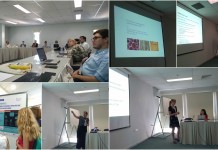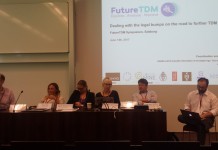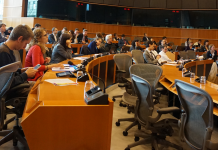The goal of FutureTDM is to promote uptake of the use of TDM in Europe. Part of the solution therefore lies in identifying barriers existing to the use and uptake of TDM in the EU. Among these are legal barriers: those which restrict the use of TDM by making TDM activities unlawful under certain circumstances, even though miners do have legitimate access to the contents to, for example, read or view them. We are therefore now in the stage of mapping the laws and regulation in the EU that restrict TDM activities. The three main fields of law that we focus on are: intellectual property laws, data protection laws and licensing.
For this purpose, it is necessary to collect a wide variety of regulations in those fields. We have therefore sent out a questionnaire among our network of contacts in Member States who possess the appropriate legal expertise to provide us insight into how the regulations in their respective countries affect TDM. We do not only focus on legal ‘barriers’, but we are also very curious about any provisions that promote TDM and might serve as an inspiration for good policy making.
We would like to already lift the veil of some preliminary findings. As of now, it seems that the biggest hurdles to overcome can be split into three categories: restrictiveness, fragmentation and uncertainty.
Restriction by Restrictiveness
The first consists of regulations that cause TDM activities to be unlawful. For example, reproductions made in the course of mining copyright protected works are not authorised by the copyright holder and are neither covered by an exception in the copyright act. Or the mined content involves personal data, which requires a legal ground for its processing in the course of TDM. We need to gather these barriers and analyse them in order to discuss how to overcome them. Being identified as ‘legal barriers’ does not mean that they need to be removed. A careful balance must be made between the interests of all stakeholders, inter alia content owners, content miners and individuals whose personal data is subject to TDM.
We have also noticed that recent developments in legislation are pointing more and more towards copyright provisions that specifically aim to exempt TDM (under certain conditions). Besides the UK exception that is in force since 2014, we also see developments in the EU, France and Estonia.
Restriction by Fragmentation
It is not only restrictiveness itself that may hamper use and uptake of TDM. National laws in the EU affecting TDM are not always fully harmonised. This results in cross-border differences regarding the lawfulness of TDM. In an environment where parties increasingly collaborate on a pan-European level, it might be troublesome to deal with a variety of laws that all differ in their restrictiveness to TDM. Furthermore, fragmentation may also exist in licensing. Some content owners may not authorise TDM, where others do. And even in the case of the right holder’s consent, this may be subject to conditions that differ among parties. Where the miner has to deal with several sources from several content owners or where miners from different Member States collaborate, this fragmentation might serve as a barrier the use of TDM. In this context, the challenge is to iron out differences to promote TDM in a European internal market.
Restriction by Uncertainty
Somewhat related to fragmentation is the legal uncertainty that lack of clarity on the applicable laws and licenses might provide to a TDM user. Which laws and which conditions must be complied with for which sources of content? Furthermore, lack of clarity also seems to exist to the scope of the applicable laws. For example, it is not always clear whether copyright exceptions cover TDM activities; it might depend on their purpose or the nature of the party carrying out the TDM. It also seems that there is not always consensus on the extent to which exceptions from copyright and database laws may be overridden by contracts. Legal uncertainty may have a chilling effect on the uptake of TDM.

The Solution?
After we have accurately mapped the existing legal barriers, the challenge of finding the right solution(s) to these problems comes into play, taking into account all interests that are at stake. These solutions may come from several actors in the field, for example, the legislator, right holders, miners, or FutureTDM itself, preferably in a joint and constructive conversation. We are therefore strongly connecting with the whole field of TDM, raising the subject with all stakeholders, for example, through interviews, workshops and knowledge cafés.













